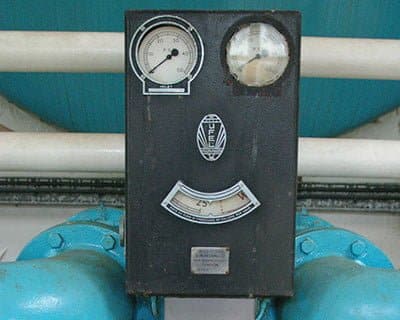 Whenever you’re pumping fluids through a pipe, you need to pay attention to your pressure drops. A pressure drop happens whenever fluid is met with resistance. That means it will happen over a stretch of pipe, through a filter or a strainer, through a valve, or any other type of pipe fixture.
Whenever you’re pumping fluids through a pipe, you need to pay attention to your pressure drops. A pressure drop happens whenever fluid is met with resistance. That means it will happen over a stretch of pipe, through a filter or a strainer, through a valve, or any other type of pipe fixture.
Pumps counter-act the pressure drops in your pipe system. In fact, you should be adding up all these pressure drops and resistances (if you haven’t already, look up Total Dynamic Head) to select a pump that is capable of efficiently overcoming them.
In other words, the pressure drop is a critical measurement that cannot be ignored.
However, we often switch out pipe fixtures with little regard to the pressure drop and its effect on our pumps and processes. We even operate our control valves without monitoring the pressure drop we’re creating, or we ignore our filters and let them clog because we don't actively monitor the pressure drop.
As we fluctuate pressure drops and resistances on our pipe system, we change the rules of engagement entirely. Meanwhile, we look at all our leaking and broken pumps and wonder why they’re always failing.
The fact is if you change the resistance of the system, you have to change your pumps to match it. If you don’t want to change your pumps, then you better not change the resistance of your system. The only way to avoid this pitfall is to monitor your pressure drop across key pipe fixtures – namely filters and valves. You have to actively keep your pressure drops in check.
Every time you touch a valve, you are altering the pressure in your pipes. If you use any filters or strainers at all, you’re changing the pressure in your pipes. Even natural build-up in your pipes over time changes the pressure. You must understand this to effectively operate a pump system.
Pressure is the most critical factor in how well your pumps operate and how long they last. In order to keep tabs on the pressure in your system, you should be monitoring it at critical points along your pipes. You should at least have pressure gauges installed on the inlet and outlet of:
Why monitor pressure on both the inlet and outlet? Because that’s how you measure the pressure drop! This is also known as the differential pressure. In fact, of those who do monitor pressure drops, many use differential pressure gauges. However, as it is useful to know the pressure on both sides, the best method is to install two pressure gauges.
Once you have the gauges installed, simply subtract the downstream pressure from the upstream. This easy differential calculation will tell you how much pressure you’re loosing to your strainers, filters, valves, and other pipe fixtures. If your pressure drops below the minimum required for your pump to run efficiently, the pump will fail and your process will grind to a halt.
Your filters and strainers might fail if not cleaned on time, resulting in unwanted particulate matter in your process, which could damage a variety of sensitive and costly equipment.
While there are several excuses for not monitoring the pressure drop, they can usually be traced to a lack of commitment to quality or a lack of understanding – one or the other. So now that you know about the pressure drop, and how critical it is to your entire process, get some pressure gauges on your filters, strainers, and valves.
Make sure, however, that you put good instrumentation on your pipes. A cheap analog gauge will give you valuable data for a little while, but it will become a failure point too quickly. Avoid a sea of failing gauges by going digital. We can help you understand your options, the improved features, and how you can enhance your process automation with digital pressure gauges from APG.
Questions? Give us a call at 888-525-7300, or send us an email to sales@apgsensors.com to learn more about how digital pressure gauges can help you keep your pressure in check and your process in motion.
top photo credit: Redmires Water-Treatment Works Uploaded by http://underclassrising.net/ via Flickr, CC